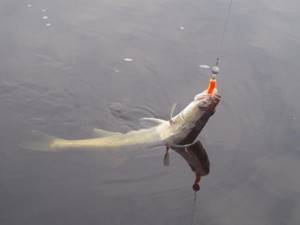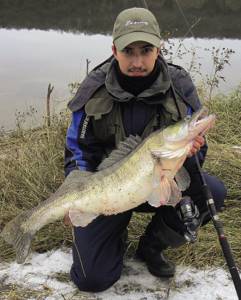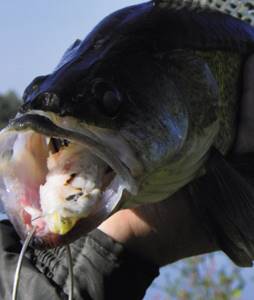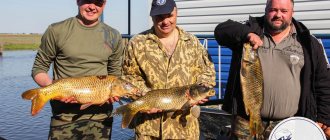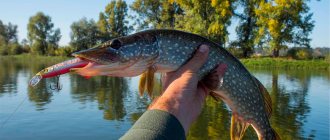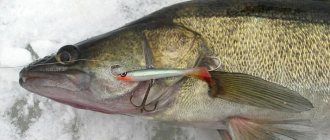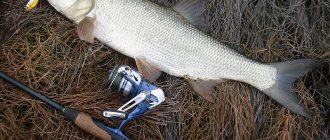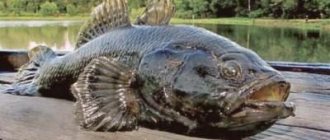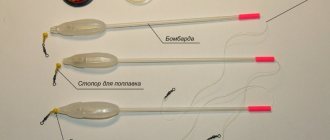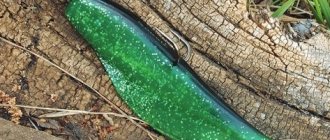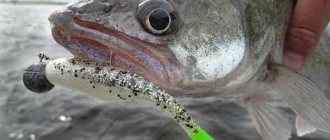Alexey Kolomiets, Volgograd | June 26, 2021
The spring ban in the Volgograd region lasts until June 15 below the Volzhskaya Hydroelectric Power Station and until June 30 at the Volgograd Reservoir. During the period of the ban, according to the rules of amateur fishing, it is allowed to fish from the shore with one fishing rod, donka or spinning rod. The only thing is that below the hydroelectric power station in June the herring is already ferocious, and with it the midge. And on the Volgograd Sea there are no midges, but pike perch and bersh are caught from the shore.
Tackle
In order to make it more convenient to further classify gear for catching pike perch, we will single out three main types of reservoirs on which fishing takes place:
- bodies of standing water (reservoirs);
- with medium flow (Moscow River, Oka);
- with a fast current (Akhtuba, Volga).
In addition, let’s take into account the circumstances that fishing for pike perch can take place both on open and overgrown shores, as well as from a boat. Now, in order.
Rods
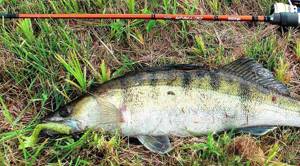
When fishing in reservoirs on open banks, rods with a length of 3 to 3.3 m with a test weight of 5-25.7-28 g are used. (on average from 5 to 30 g), on overgrown trees and shrubs - with the same tests, but already 2.4 - 2.7 meters long. In addition, for fishing near edges, rods of various lengths with a test weight of 0-10 g can be used.
On medium-current reservoirs, for fishing on open banks, rods with a length of 3 to 3.3 m with weights ranging from 7 to 40 g are suitable; on overgrown banks, it is more advisable to use rods with a length of 2.4 to 2.7 m. Fishing pike perch for spinning in shallow water, in whirlpools allows you to use rods with a weight of 2 to 20 g.
In cases where you have to catch pike perch on the Volga, Akhtuba or other rivers with fairly fast and powerful currents, you will need rods with a weight of 20 to 150 grams and a length of 3.3 - 3.6 meters.
As for the spinning rod action, on reservoirs, in cases where long casting is not needed, you can get by with rods with a Medium action, but on rivers it is advisable to have Fast rods. The point here is that on reservoirs with a strong current, rods with a Medium action will stop working on the load falling to the bottom, and the tip will be constantly “pressed” to the water. The difference in rods when fishing for pike perch with a jig from a boat will only be in length (usually it ranges from 1.8 to 2.7 m), the tests in accordance with the conditions are the same as when fishing from the shore.
Reels
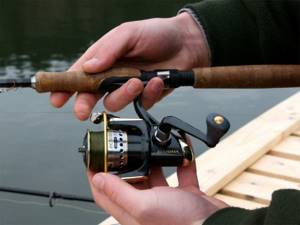
When fishing for pike perch, spinning reels are used with a line capacity (monofilament - since the markings on the spool are in monofilament) from 100 m with a diameter of 0.2 mm to 200 m of the same diameter. That is, mainly reels of the 1000, 2000 and 3000 series. Accordingly, the “thousander” is for fishing in still water, in cases where long casting is not required, and is perfect for gear for pike perch, and the “three-thousander” is already on rods with a length of 3 m for long casts, in the current.
When fishing on the Volga and Akhtuba, reels up to the 5000 series can be used, depending on the length and test of the rod. It is better to purchase cords in unwinding lengths of 150 meters or more, and take up the extra space on the spool with backing, winding an old monofilament under the cord. The gear ratio of the coils is from 5:1 - 6:1, the power on the handle is from 2.5 kg and above.
Cords
For fishing in still water, cords with a diameter of 0.06 mm to 0.12 mm are used with baits up to 12-14 g (sometimes up to 20 g, when fishing holes up to 10 m deep). On the average current, braids from 0.1 to 0.16 are used (Moscow River, Oka River), on strong currents (Volga, Akhtuba) from 0.12 to 0.2 mm. When fishing in a current, it is advisable to use round braids (they float less), and in still water, flat lines are also quite suitable.
Lures
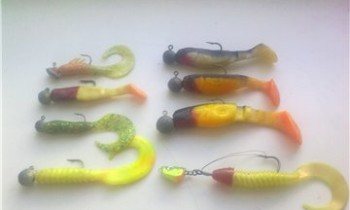
On still water, weights from 0.5 to 7-8 g are used (in pits up to 14-16 g), on average flow, weights from 10 to 28 g are used (on the Oka and Moscow rivers there are places where you have to use weights up to 35 g.), in strong currents (Volga, Akhtuba), weights from 22 to 150 g are required (here, such a spread in weights arises due to the variety of fishing places). To catch pike perch, almost the entire arsenal of jig baits is used: various twisters and vibrotails, octopus and mandula, a variety of foam fish. The size can be any, from small baits, 2 centimeter twisters, to large fifteen centimeter vibrotails. The most catchy baits are natural colors: green, white, yellow, orange, pearlescent, acidic, transparent baits and various colors in combination with sparkles (usually green).
Spring pike perch of the Volga

Around mid-April, wonderful, long-remembered fishing begins on the Lower Volga, on its channels and eriks. Once upon a time, we came here in friendly groups and settled down as “savages” on the banks of the Mother Volga or on one of its channels. Now, of course, the situation is different. The fish stocks here, although thinned out, have not dried up. And one of the prestigious trophies, of course, should be called pike perch.
That April morning, my friends rushed off to the Kalmyk steppe at the crack of dawn in a UAZ, colloquially known as a “loaf”, in search of fish eriks, and I decided not far from the camp to go after the pike perch of the Kharabalyk River. In a fairly strong crosswind, my spinner with a tee equipped with red hairs did not always splash down in the right place, and then I, slowly rotating the handle of the spinning reel, moved the bait along the current or across it in the hope of a “blind” strike. Empty. After the next cast, at the risk of breaking the spoon, I make a stepwise retrieve at the bottom and during one of the short pauses I feel a light blow through the rod. I was ready for immediate hooking; I hooked it quite sharply and felt a weight at the end of the line. After several minutes of struggle, I had a pike perch weighing three kilograms in my hands. For some reason I decided that I should replace the one-of-a-kind spinner with a jig (yellow twister). And he did the right thing: before noon I caught a couple more wonderful pike perch. I had plenty of yellow and yellow-green twisters, and I often had to tear them off after dead hooks, since the section of the river where I was fishing was literally crammed with underwater obstacles. It’s surprising that I didn’t break off my favorite spinner.
ON THE WAY TO THE SPREADING GROUND
In local areas, as well as in other regions of Russia, the main feature of early spring pike perch fishing is that you need to clearly guess the timing. You can be sure that the pike perch will take here and there, but you don’t know exactly when. It is important to have a good idea of when pike perch will deign to go to spawning grounds. In the lower reaches of the Volga this happens in a fairly short period of time - before the flood.
River walleye on their way to spawning grounds (usually rocky or shallow gravel areas) make stops to hunt for small fish. And if you find yourself in a fattening flock, success is guaranteed.
A week or two before spawning, fanged fish gather in schools, and fishing during this period can be very successful. But here’s the thing... In my opinion, the time has come when we cannot be thoughtless about the fish stocks of our reservoirs. Judge for yourself: an adult large female pike perch can lay up to a million eggs.
|
| Photo by Anatoly Mailkov |
So is it worth chasing so-called trophy predators in the pre-spawning period in order to eat them? Let the fish prolong its genus, and its population will increase from year to year. That’s why my friends and I have been catching pike perch in recent years mainly “for fun”: catch and release!
FISHING FROM SHORE
Coastal fishing is especially appropriate on the Volga channels. Here you can always find suitable places for casting fishing. Unlike, say, the rivers of central Russia, the banks here are covered with sparse trees and shrubs. So it's easy to move around. In this case, it is preferable to fish calm deep holes, backwaters near a steep bank, where the bottom drops sharply into depth. Often a concentration of pike perch can be found on the breaker stream behind the capes. At early dawn, a flock of fanged predators in pursuit of the same small roach or roach can go to the shallows. In this case, high boots will allow you to wade fishing. The only drawback of fishing from the shore is frequent snagging on stones and bottom debris and loss of bait. Therefore, there should be as many of them as possible, including non-sticking models.
It also happens that you fish from one point all morning. One day on Mitinka I came across one of these places. The right bank, along which I moved with a spinning rod, was about five meters high and dropped steeply into a deep pool, on the surface of which white flakes of foam swirled. The very first casts brought me a kilogram of zander, which I generously released, asking him to send me his “grandfather”. And the “grandfather” came, that is, a huge zander took a foam rubber fish in a non-clinging version. My God, what a fight it was! I was deprived of maneuver, since I was huddled on a tiny “patch” of a steep clayey shore. After fifteen minutes of stubborn struggle, I finally brought the fanged one to the water’s edge and was already reaching for the landing net, when my opponent opened his mouth, shook his head and was gone. That morning I couldn’t come to my senses for a long time. And for several days I completely forgot about non-snagging baits.
IN FREE DRIFT
On the Akhtuba, Buzan and other fairly large channels of the Lower Volga, spinners often use the most universal method of catching spring pike perch - using free drift on a boat. Now at fishing bases located in the lower reaches of the Volga, you can be provided with a boat or boat that is equipped with a gasoline engine. You won’t be able to catch “quietly” with such a craft even if you want to. But moving to any point on a particular body of water is usually not difficult. By motor, you can go up a river or channel and, having chosen a suitable area, silently float downstream, fishing at various water levels until you discover a flock of fanged predators. Now you can drop anchor to cast.
However, sometimes pike perch are more willing to attack bait that is not carried away by the flow, but follows strictly against the current. In this case, experienced paddle boarders act as if backtrolling, slowing down the boat and backing it up (you can do this with the help of oars). This tactic allows you not only to neutralize the free drift of the boat, but also to use baits that require slow and particularly delicate retrieval. For example, rigs with dead or live fish, as well as tandems.
|
| Pike perch raised from great depths sometimes regurgitate the contents of their stomach. |
When talking about spring pike perch fishing, I deliberately avoid the trolling method of fishing. The fact is that when catching early spring pike perch in pits using stepped fishing, there is no guarantee that the hook may occur not on a snag, but on a giant catfish that has not yet woken up from hibernation. You most likely won’t be able to take it, but you will definitely injure it. In general, it must be said that for spring pre-spawning pike perch, in most cases, any fast fishing is contraindicated. This behavior can obviously be explained by the fact that at this time the water is still quite cold. Since before spawning, pike perch are very picky in choosing both natural and artificial baits, a small jig, in my opinion, is the best bait in the spring, when the abdominal cavity of the fish is filled with reproductive products - caviar and milt. You can fish with jig not only in the water column, but also at the very bottom, using a very slow retrieve rate. The most important problem in this case is the inability to use light, most catchy jig baits in fast currents. However, experienced court fishermen have long ago solved this problem for themselves. In essence, this is a very simple method that they use when fishing in a strong current. The equipment consists of a fairly heavy sinker and a light jig (twister, vibrotail, octopus), which is attached behind the sinker on a leash 40-50 cm long. The leash should not be stronger than the main fishing line, preferably braid. If you use monofilament, do not forget that the hook should be more sweeping. Otherwise, you will not always be able to cut through the bony mouth of a predator with a hook.
In combination with a light jig, a regular spinning sinker is suitable, the weight of which is selected depending on the depth and strength of the current. During a stepwise retrieve, the sinker periodically touches the bottom, dragging the jig along with it and provoking the predator to grab it.
FROM THE BOAT Plumb
This fishing is somewhat reminiscent of hunting for pike perch from the ice. In the Lower Volga, the most promising places for vertical fishing from a boat are the outlets of bays, channels and rivers. There is no strong current here, and you can use not only light jigs, but also vertical spoons and balancers.
On Enotaevka, for example, there are many places where a meeting with pike perch is guaranteed. But that day everything was not in my favor. While I was wasting my time casting with a spinning rod, huntsman Nikolai, with whom we spent a whole week motorboating along the Volga channels, without a rod at hand, tied a green twister on a jig head to the fishing line, lowered it to the bottom and began to play with the bait, winding the fishing line around finger. About ten minutes later he hooked and pulled out a small zander from a depth of seven meters. "Wow!" - I said and also switched to fishing vertically. In my box there were several balancers, which the local pike perch really liked. Without turning on the engine, we used the oars to change one place after another, carefully lowering the anchor to the bottom. The result of that fishing was six pike perch.
|
| It is in the spring that large pike perch become a frequent prey for spinners. |
To this day, I am at a loss as to why the pike perch that day refused to take silicone baits during stepped and horizontal retrieves. In recent years, I have increasingly tried to use soft silicone baits not on jig heads, but on “eared” weights, which, due to the swivel connection with the hook, provide a greater degree of freedom during the retrieve. In addition, twister tails can be successfully used as equipment for vertical spinners and even balancers.
AT TWILIGHT AND NIGHT
Twilight is the best time to catch fanged predators. This is well known. At night the bite is not stable and largely depends on the season, weather and other conditions. At the same time, it must be said that night fishing in April on the Lower Volga is not particularly comfortable. Its main feature is that you need to “grope” for the place where pike perch are currently holding before dark.
If during the day during this period the southern sun is already warming up well, then at night it is usually cold, strong winds often blow, including the wind characteristic of these places under the ancient name “moryana”. When the moray begins and pushes the salt water of the Caspian Sea into the river and its tributaries, the fish seem to freeze and do not take any bait. At night, pike perch can be active for only 1–2 hours and at different times. And hanging around the river in the cold wind all night with a spinning rod is not the best option. Therefore, most often fanged hunters try to catch it in the morning and evening twilight. It has also been noted that local pike perch bite best in cloudy weather, especially during or after spring rain, which saturates the water with oxygen and makes it cloudy.
Vladimir Kazantsev March 31, 2014 at 00:00
Techniques and tactics of fishing from a boat
Pike perch on a large river, for example on the Volga, often lives in deep holes under a steep bank and in snags, so you can’t do without a boat on the Volga. The technique for catching pike perch from a boat is usually as follows. During slow rafting downstream with a spinning rod, the bottom is tapped using a jig bait. Usually, pike perch stands at changes in depth and bites often occur in these places. Thus, fishing on a large river, on the Volga or Don from a boat can bring good catches.
Catching pike perch with jigs on reservoirs differs from fishing on the Volga. You have to cover large spaces and you can’t do without an echo sounder. Having found a promising place, they begin to fan-fish the area they like. Typically, a stepwise technique of bait placement is used. Fishing for pike perch in reservoirs requires a lot of time to find a promising place, but once you find one and “enter a point” into the navigator, you can get good catches more than once.
Fishing for pike and perch in spring
Pike, like perch, should be looked for in spring exclusively in relatively shallow, quickly warming eriks and channels of the Volga. These fish spawn in them when the water rises. Fishing for pike and large perch at this time of year is extremely interesting and challenging. Even if you came to the Lower Volga exclusively for pike perch, I still advise you to devote one or two days to fishing for pike and large perch.
The baits that are best used for catching pike are no different from those used for catching pike perch. True, we no longer need weights greater than 50 grams, although when using them, fish bite, but not as often as when fishing with lighter baits.
For pike, it is best to go to the Zamyan region, to the channel that forms an island near the village of Pribrezhny, called “Pike Erik”. You should look for pike in it all the way from the hole, next to which there is something like a pier. If you want to catch large perch, then it is better to use small baits, with a weight of no more than 30 grams. Perch bites are possible throughout the entire trip. I had one funny incident: a very decent-sized perch bit not far from the boat, and when I brought it to the boat, I noticed several more perches (it weighed 900 grams) of the same size, which were trying to snatch the bait from its mouth. The next casts to this place ended with the capture of several more approximately the same striped beauties. It should be noted that the large perch stayed in the pit itself, while smaller counterparts were caught a little further upstream, at the entrance to the pit itself, and attacked a jig of almost any size and with a load of 70 grams. The use of light jigs and lead rigs only led to the catching of very small perches.
Why do pike and perch live in such places in the spring? The answer to this is quite simple: adjacent to the holes and deep places are vast, grassy, shallow areas of eriks and channels. It is in these places that there are spawning grounds, where, with the rise of water after discharge from the Volgograd hydroelectric power station, pike and perch will rush to spawn. The most important thing: since the fish that are caught during this period have not yet spawned, when fishing you need to adhere to the “catch and release” principle and carefully release it back.
So, you should look for pike in the spring near the spawning grounds, but in those places where there is a depth of 3 to 8 m. You shouldn’t go small with the size and weight of the baits used - the optimal twister size is 5-6 inches. Salt Shaker vibrating tails and Action Plastics 5 FG twisters in chartreuse colors work best. Cargo weight - 50 g. If you use lighter loads, which are considered optimal for such depths, then you may not get a pike bite. Or you will come across a small perch. I don't know exactly why this is so. But the fact remains that in the spring, pike in these parts love to “eat” heavy baits, the weight of which, it would seem, exceeds all reasonable limits. Maybe the pike is provoked to attack by a sharp, broken movement, or maybe the bait creates strong vibrations that force the pike to rush to the jig. Or maybe all these factors together give such a result. Other assumptions can be made in this regard. Or you can just fish for your own pleasure.
When fishing in eriks, you shouldn’t stay in place for a long time if there are no bites. If the fish does not bite, it means that it is not in this place, and you need to swim and look for pike further. If there is a pike in a given place, then it manifests itself on the very first cast, either by biting or catching. But this does not mean that if you cast once and did not catch anything, then you need to swim further. It’s better to fish in different directions. A dozen casts in different directions will be enough. If there is a partner in the boat, then you can distribute the roles as follows: you make five casts from one side, in different directions, and the partner makes five casts from the other side. If this does not bring any results, feel free to swim further. True, not in every erik you can find a concentration of pike. Sometimes in search of pike you have to move around a lot, so, I repeat, a spare tank of gasoline will not be superfluous at all.
A fairly promising method for catching pike is fishing with jerkbaits. But since I myself have not fished with this gear in those parts, I will not dwell on it in detail. Why then do I recommend this method of fishing? In order to understand the effectiveness of this gear, you don’t have to fish with it yourself. It is enough to watch those who are fishing nearby.
Also, a large number of pike can be found in flooded eriks, which in the spring are filled with water from the main Volga. A lot of pike come into them to spawn and stay there. As a rule, these are quite small laces. But they come across almost every cast. It is best to fish in such eriks with fairly large minnow wobblers. Naturally, they need to be carried out by twitching. I will not discuss specific models, since all wobblers with a length of 9 cm or more and carried unevenly do not go unnoticed. The color of the bait also has no effect. The main thing is to choose the wiring and temp. Although large pike are not found in such places very often, fishing in such reservoirs is interesting due to the number of bites. Such eriks are an excellent testing ground for various experiments and wiring practice. In clear water and at shallow depths, all movements of the bait are clearly visible. Sometimes you can even see a pike attacking a wobbler.
Method of fishing a place from the shore
Jig fishing begins with choosing the weight of the bait.
When we arrive at the fishing spot, we first attach a heavy load and cast as far as possible. If the bait drags along the bottom when reeling in, lighten the load and again make a long cast. We lighten the load until the load begins to rise from the bottom on the reels and the pause in the fall becomes equal to 1.5-2 seconds (after 1-2 turns of the reel handle). After this, we begin to experiment and change baits, change color, size, type; We try twisters, vibrotails, octopus, foam rubber of several sizes and colors, since jig fishing is a constant experiment. Catching pike perch with a jig from the shore also involves stepwise retrieval. The technique is as follows: after casting the bait, wait until it sinks to the bottom. After this, we make 2-3 turns of the reel handle and wait for the bait to sink to the bottom again, and so we lead the bait to the shore. The bite most often occurs during a pause, but can occur both when the bait is lifted from the bottom, and while the bait is moving. Sometimes pike perch can follow the bait for quite a long time and grab it literally “under the feet” of the angler.
Nuances of long-range materiel
First of all, for long-range shooting you need a long spinning rod, which has 35 g - just above the middle of the test. Well, for example, the ideal test would be 10 - 50 g. Well, the length should be about three meters. And with all this, the form must be “ringing” in order to feel bites on the release, to monitor sticking and all kinds of pressing of the bait by the fish. After all, the bites are not always the kind that people say “give back the spinning rod” or “a bite in the leg.”
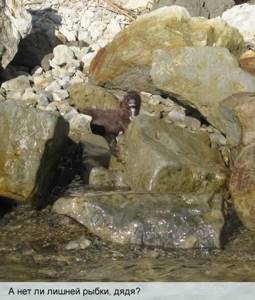
Long casting and current do their job. It happens that a good pike perch simply hits the form, as if a fly had hit its head on a spinning rod. You need to strike with a sweep, because the more “braid” in the water, the greater the likelihood of blowing out a small arc, which gives the fish a chance to come to their senses and spit out the bait.
My first spinning rod for this type of fishing was the Hearty Rise SeaBass Force SB-1002MH (12 - 50 g). Once upon a time I took it for a trip for taimen, and then used it for catching asp on Big Water with heavy jigs. The spinning rod turned out to be loud enough to jig in the described conditions. I was looking for a second spinning rod for friends who sometimes come to visit. After all, jigging from the shore to the BB occurs in the second half of May and all of June.
And this is only 6 weekends, of which, God willing, you will carve out half for a trip to the reservoir. That's all! Then the spinning rod will remain in the closet until next year. At least that's what happens to me. So what, buy a special spinning rod for three fishing trips a year? I'm lucky, I fish more often than many of my friends and comrades. For this reason, I decided to purchase a second spinning rod with similar characteristics. It was Mottomo Balista MBLS-1002MH (12 - 45 g). This spinning rod is a little faster when using 35-gram weights, but if you fish with 41 g, the Khertik is preferable.
Balista’s sensitivity is also in order. Probably, you can find a more “ringing”, more jigging three-meter spinning rod, but I will repeat that I also use these same spinning rods for catching asp, when I also need to cast from the shore as far as possible. Definitely, these forms will have a higher sending power than a purely jig tool. I chose versatility - and so far everything has worked out for me.
As for reels, I use sizes 3000 and 4000. In both cases, Daiwa . In size 4000 I have an old Certate Hyper, which was still produced in a metal case. Absolutely a traction reel, which is important when you are trying to rip a pike perch to the surface as quickly as possible before it hits its head in the “quarry”. Of course, high-quality winding is simply necessary. Otherwise there will be dashes, loops and shooting of baits. But my friend has been fishing with a Stinger Aggregate SF 3500 reel for three years now - and doesn’t think about anything else. He is satisfied with everything - both winding and traction characteristics.
The “braid” must be wound under the very collar of the spool. I'm not being clever - I'm just reminding. Every meter counts. You can wonder for a long time why others fish through a cast, but you get one bite from a dozen casts. But a slight slight is a shame, as Internet addicts say. We even often pit the “braid” while it is plunging into the abyss. I rarely do that. Sometimes, when an asp falls, it can kick, and sometimes it is useful to “meet” the bottom on a deliberately tensioned cord. I will not name any specific brand of cord.
I'm afraid I'll be subjective. Everyone fishes with what they are used to and are confident in. Most importantly, it is abrasion-resistant cord with a breaking load of 15 lb. It could be a little thinner, but just a “speck” is enough for me, and I consider this the golden mean. It seems that reducing the diameter of the “braid” and using slippery PE cords will give an advantage in casting. I tried. Yes, cast further. But getting the fish out is much less likely. PE cords cut on the shell the first time they touch it.
Pike-perch parking areas
In the early morning, pike perch prefers to be closer to the shore (on the 1st and 2nd edges); during the day, “shelling” of long distances and the riverbed area begins. Towards evening there was another shelling from the riverbed to the 1st and 2nd edges. It is also important to take into account the direction of the wind; catching pike perch with a jig is more effective from the leeward shore. Pike perch loves holes, which are quite deep, with a hard bottom: sandy, pebble or clay; It has been noticed that pike perch does not like to stay on the bottom with the presence of silt. Has a positive attitude towards snags. It can only enter the grass during spawning of bleak, its favorite delicacy. Likes to stand on stones, in holes, at the entrances and exits of them, near the remains of railway embankments and bridges.
The most favorite depths are 3 m or more; they often follow the fry into shallow water, especially at night. It is easy to detect the hunting location of a flock of pike perch by the seagulls flying above the water: the pike perch squeezes the fry to the surface, and the seagulls attack the fry from the air. When reaching the point, a fan-shaped “lumbago” of the surrounding space begins, taking into account that while guiding the current, the bait is carried to “interesting” places.
- Bends in the river
- Fall into depth
- Pit
- Mounds

Methods and gear for autumn fishing for pike perch in Trekhrechye
From September to November in Trekhrechye, pike perch are caught using the same gear as in spring and summer, but taking into account work at greater depths, especially from the second half of October. If in September lures still work effectively for pike perch, then as the water temperature drops and the predator moves deeper, fishing with jig gear and trolling with deep-sea wobblers becomes more and more effective.
At the end of November, pike perch can only be taken on a vertical line when trolling vertically or on a wobbler with a depth of 6-10 meters when trolling from a boat.
Depending on the type of gear and fishing method, the main fishing line is used
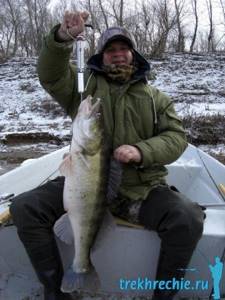
braided cord 0.18-0.20 mm in diameter or monofilament line 0.20-0.24 mm.
Leashes are not used when fishing for pike perch; it does not have sharp body protrusions that are dangerous to the fishing line. However, the powerful jaws of the pike perch, equipped with four needle-shaped fangs, for which it is nicknamed “fanged”, should be feared. Sticking your fingers into the mouth of a live pike perch to take a super-selfie is dangerous to your health. However, if pike bites are very likely when fishing for pike perch, you can play it safe and use a leash made of fluorocarbon fishing line, titanium thread or cord.
Biting and fishing
Pike perch bites can be divided into three types:
- bite with a blow;
- hanging (if he takes the bait after him);
- chasing after the slack line (when the pike perch, after hitting the bait, goes forward with it, this is how a large pike perch usually bites).
Hooking should follow immediately after detecting disturbances in the movement of the bait; when biting with a slack line, hooking with the rod is done while simultaneously reeling in the fishing line . After hooking, you take the pike perch to an average distance (about 10-15 m), trying to keep it in the upper layer of water (up to 2 meters from the surface). The friction is adjusted to approximately 50% of the breaking load of the fishing line.
